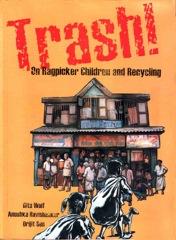

It is not often that one gets to read a real-life inspired story of street children and ragpickers, at that. What is life like for these children whom we see, and yet, do not see? What are their fears? Their hopes? Their aspirations? That is presuming that they do get to rise above their day-to-day struggles and envisage a future for themselves.
Velu, a twelve year old boy, migrates into the city of Chennai, where he meets Jaya, a ragpicker. She takes him under her wing and provides him with the life skills necessary for survival in the streets; a valuable ‘internship’ of sorts! Quickly, Velu learns what makes for lucrative garbage, how to demand his rightfully earned dues (when the rag dealer pays them less), how to budget his expenditure and also avoid being exploited.
After reading this book, I am sure that the next time a child encounters one such Velu or Jaya, she will remember that behind those dirty faces and grimy clothes are children. Children just like them who enjoy friendship, feel fear, have fun. Children who want to laugh, be happy, and occasionally enjoy the luxury of a belly full of food.
Interspersed all through the narrative are snippets of information on the trade, agencies that help, the story of paper and more. Although, the information is very useful it does disturb the flow of the story.
That said, the well-researched information will provide a very useful tool to teachers to carry on discussions in the classroom on waste management – the why, how and what of it.
Young India Books recommends.
Comments
Review submitted for LRSI - '14
I liked this book because it tells us about child labor, how rag pickers clean the environment, what difficulties they face, how their childhood is lost and under what circumstances a child from a village becomes a rag picker. I found the book very interesting and felt that it was like a movie, the more I read the more I wished to read ahead. But I think that the ending could have been better and happier.
Trash is a novel about Velu, a young boy, who escapes a drunk, abusive father in his village to go to Chennai. He meets Jaya, a sharp rag-picking girl, who initiates him to rag-pick and teaches him the tips and tricks of the trade. Jaya is shown "worldly wise", in terms of looking after herself, arguing with the trash dealer for better money for the trash she has collected, or in acceptance of the fact that the police will beat her even if she hasn't done anything wrong. Velu is shown as a guileless newbie who's dependent on Jaya for his day-to-day survival. Velu lives and sleeps on the pavement and rag-picks to earn money, as he can’t get any other job. He hates rag-picking and is always looking out for something better to do.
The situation becomes worse when Velu takes loan from money lenders and has to repay it. Velu meets good people too, like the priest who teaches him and the social workers who conduct workshops with them.
The book is well styled, the illustrations are interesting, featuring a combination of both photography and rendering with simple graphics, appear throughout the book, giving information on waste, trash, the different types of trash, the methods of trash, etc.
Rachiet Shah
Grade 7
Arya Vidya Mandir
Bandra (E)
Mumbai
Review submitted for LRSI '14
“ But, akka, if our work is so important, why don’t we get more money for it?”
Our country India is known to have the most number of child laborers in the world. Children in our country work to make firecrackers and also work as ragpickers due to which the often fall sick and sometimes die. They are not even paid the right amount for the amount they work. In fact ragpickers help our country by picking up some of the waste and also recycling the waste by giving them to dealers.
This story of trash is about this young boy velu who runs away from his village because his father beats him. He goes to the city of Chennai, but when he reaches there he wonders what he is going to do. That time a ragpicker child Jaya sees him and says that he can join her in the profession of ragpicking. He does work all day long sorting garbage but at the end of the day he gets only five rupees. This goes on everyday with sometimes more money sometimes less. But this life have some highlights also. Like – going to school on Wednesdays, watching movies on Fridays, going to a workshop from school to tell people about ragpicking and going to a paper factory.
I really like the character of Jaya because she always helps Velu and is very sweet to him who very less people are and I really hate the character of Dorai, as he is very cruel with velu.
I really like this book as it gives us a lot of information on ragpicker children and recycling. Actually, not only that, it also provides these educational blocks every two pages that actually gives information about real things In life according to things going on in the book.
I really give a lot of credit to the writers Gita wolf, Anushka ravishankar and Orjit Sen. I suggest you all read this book, as you will come to know a lot about our country India and its child laborers.
SUNAYANA JAIN
7-A
ARYA VIDYA MANDIR
JUHU
MUMBAI